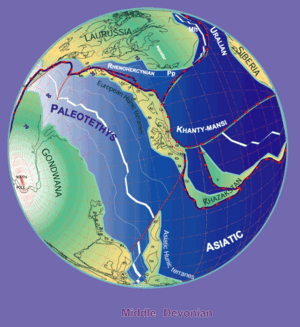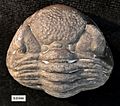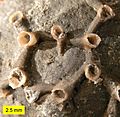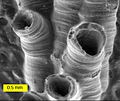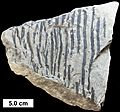Devonian facts for kids
The Devonian Period was a time long, long ago, from about 419 million years ago to 359 million years ago. It's the fourth part of the Paleozoic Era, which is a big chunk of Earth's history called the Phanerozoic Eon. This period gets its name from Devonshire, England, where scientists first found and studied rocks from this time.
During the Devonian, the oceans were full of life! There were many different kinds of fish and other sea creatures. Some of the fish included:
- Jawless fish (Agnatha)
- Spiny fish (Acanthodii)
- Armored fish (Placoderms)
- Cartilaginous fish (Chondrichthyes), like early sharks
- Bony fish (Osteichthyes)
This period is divided into three parts: early, middle, and late Devonian.
One of the most exciting things that happened in the Devonian was the evolution of fish into tetrapods. These were the first animals with four limbs that could live on land! Also, many land-dwelling arthropods (like insects and spiders) started to appear. The very first seed-bearing plants began to grow on dry land, eventually forming huge forests.
The Earth's continents looked very different back then. A giant landmass called Gondwana was in the south. To the north was the continent of Siberia. In between them was a smaller continent called Euramerica. All these continents were slowly moving closer together, starting to form the supercontinent Pangaea.
By the end of the Devonian, plants and insects had spread across the land. In the oceans, huge coral reefs were built by tiny creatures. Euramerica and Gondwana continued to move closer, getting ready to become part of Pangaea.
The End of the Devonian: Extinctions
The Devonian Period ended with some big changes. There was a lot of tectonic activity, meaning the Earth's plates were moving a lot, and many volcanoes were active.
Towards the end of the Devonian, there were a series of extinction events. This means many types of plants and animals died out. One major extinction happened about 372.2 million years ago, at the start of the last part of the Devonian. Almost all the jawless fish suddenly disappeared.
Another big extinction happened right at the very end of the Devonian Period. This "Late Devonian extinction" was one of the five largest extinction events in Earth's history. Scientists are still trying to figure out exactly what caused these extinctions.
Images for kids
-
Dunkleosteus, one of the biggest armored fish ever, lived during the Late Devonian.
-
A painting from 1905 showing an early shark Cladoselache, several lobe-finned fishes (like Eusthenopteron, an early marine tetrapod), and the armored fish Bothriolepis.
-
An enrolled phacopid trilobite (an ancient sea creature) from the Devonian of Ohio.
-
The common tabulate coral Aulopora from the Middle Devonian of Ohio. Here it's growing on a brachiopod shell.
-
A Devonian spiriferid brachiopod from Ohio that had a colony of hederelloids growing on it.
See also
 In Spanish: Devónico para niños
In Spanish: Devónico para niños


